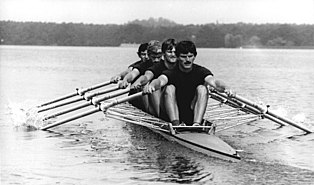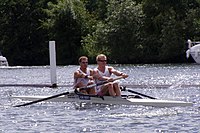Sculling

Template:ChineseText Sculling generally refers to a method of using oars to propel watercraft in which the oar or oars touch the water on both the port and starboard sides of the craft, or over the stern. By extension, the oars themselves are also often referred to as sculls when used in this manner, and the boat itself may be referred to as a scull.
Two-oar sculling

Two-oared sculling is a form of rowing—both competitive and recreational—in which a boat is propelled by one or more rowers, each of whom operates two oars, one held in the fingers of each hand.[1] This contrasts with the other common method of rowing, sweep rowing, in which each rower may use both hands to operate a single oar on either the port or starboard side of the boat.[2]
Sculling in crew
Sculling forms one of the two major divisions of crew, or competitive rowing, involving races between small, sculled boats with various numbers of rowers. Generally, one, two, or four rowers row these shells, which are classified according to the number of rowers that they can hold: singles have one seat, doubles have two seats, and quads have four seats. In keeping with this pattern, quads rowed by three people (due, for instance, to a temporary shortage of rowers) are often colloquially referred to as "triples."
Competitive crew requires an efficient stroke with all rowers matching the cadence and movements of the stroke seat, the rower closest to the shell's stern. The shell may have a coxswain, or "cox," to steer the boat, encourage the crew, and monitor the rate, though coxswains are highly uncommon in competitive sculling shells.
A key, and often overlooked, technical difference between sculling and sweeping in crew is that the sculling oar handles overlap twice during the stroke, while sweep oar handles never overlap during normal rowing (because each sweeper usually holds only one oar). The overlap occurs at the midpoint of the drive and again during the recovery; because of this, scullers must hold one hand (conventionally the left hand) higher than the other at the point of overlap. To prevent this from impacting the balance of the boat, one oarlock (conventionally the port one) is rigged higher than the other prior to rowing.[3] This prevents the oar handles from colliding with one another and causing a crab or other problems.
Single-oar sculling
Single-oar sculling is the process of propelling a watercraft by moving a single, stern-mounted oar from side to side while changing the angle of the blade so as to generate forward thrust on both strokes. The technique is very old and its origin uncertain, though it was probably discovered independently several times by different peoples. It is known to have been used in ancient China,[4] and on the Great Lakes of North America by pre-Columbian Americans.
In single-oar sculling, the oar pivots on the boat's stern, and the inboard end is pushed to one side with the blade turned so that it generates forward thrust; it is then twisted so that when pulled back on the return stroke, the blade also produces forward thrust. Backward thrust can also be generated by twisting the oar in the other direction and rowing. Steering, as in moving coxless sculling shells in crew, is accomplished by directing the thrust. The oar normally pivots in a simple notch cut into—or rowlock mounted on— the stern of the boat, and the sculler must angle the blade, by twisting the inboard end of the oar, to generate the thrust that not only pushes the boat forward but also holds the oar in its pivot. Specifically, the operation of the single sculling (oar) is unique as turning the blade of the oar in figure 8 motions operates them. It is not hoisted in and out of the water like any other traditional oars. The objective is to minimize the movement of the operator’s hands, and the side-to-side movement of the boat, so the boat moves through the water slowly and steadily.

This minimal rotation keeps the water moving over the top of the blade and results in forces that transfer to the multi directional row-lock, or pivoting mount, on the side of the hull thus pushing the boat forward. Steering the boat is just a matter of rotating the oar to produce more thrust on a push or pull of the oar, depending upon which way the operator wants to go.
China
The Chinese "yuloh"[5] (from Chinese: 摇橹; pinyin: yáolǔ; Wade–Giles: yaolu) is a large, heavy sculling oar with a socket on the underside of its shaft which fits over a stern-mounted pin, creating a pivot which allows the oar to swivel and rock from side to side. The weight of the oar, often supplemented by a rope lashing, holds the oar in place on the pivot. The weight of the outboard portion of the oar is counterbalanced by a rope running from the underside of the handle to the deck of the boat. The sculler mainly moves the oar by pushing and pulling on this rope, which causes the oar to rock on its pivot, automatically angling the blade to create forward thrust. This system allows multiple rowers to operate one oar, allowing large, heavy boats to be rowed if necessary. The efficiency of this system gave rise to the Chinese saying "a scull equals three oars".
Modern single-oar sculling
Modern single-oar sculling vessels come in many shapes and sizes and range from being traditional cargo barges and fishing boats to being basic or fun transportation. Either way, they are typically most identifiable by their often side-mounted, unidirectional row-locks and oars, which allow the operator, ideally, to use one hand to operate the boat. One of the greater attractions to these vessels is that they are easy and inexpensive to operate.[citation needed] The typical modern barge-shaped and “flats”-style boats are still made from materials ranging from a variety of wood products, fibreglass, reinforced concrete,[citation needed] or metals. Some are simply converted old motor boats. The traditional advantages of the smaller sculling craft as a hunting boat are that the operator can quietly sneak up upon fish and fowl without splashing or otherwise disturbing the still calm of the water. New commercially available single sculling hunting boats use very light materials and slick shapes for greater speeds and responsiveness.[citation needed] Notably, the oars of the more modern single sculling vessels are now more typically mounted to pivot off one side of the boat. The operator can face either forward or aft.
See also
References
- ^ http://www.peinert.com/Peinert_sculling_primer.pdf, page 4
- ^ http://www.usrowing.org/NewToRowing/ElevenInsightstotheSportofRowing/index.aspx. Insight 3.
- ^ http://www.peinert.com/Peinert_sculling_primer.pdf, page 6
- ^ "The Shorter Science and Civilisation in China" by Joseph Needham, Colin A. Ronan, Cambridge University Press, 1978 ISBN 0-521-31560-3, ISBN 978-0-521-31560-9
- ^ http://freepages.genealogy.rootsweb.ancestry.com/~fassitt/cranks/cranky_sampans.html
External links
- "Cranks with Planks presents Sampans -n- Yulohs" (includes excerpt from G.R.G. Worcester's Junks and Sampans of the Yangtse.)
- "How To Scull A Boat" (Good article including several diagrams).
- USING HANDS WHILE SCUBA DIVING why you shouldn't!

